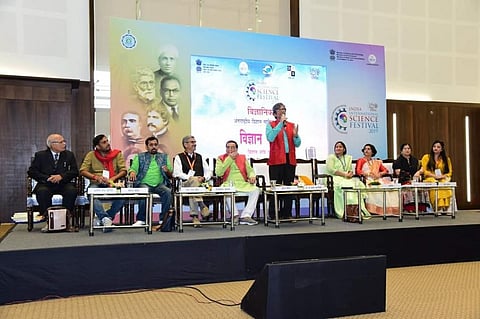

A special event called ‘Vigyanika’ at the ongoing India International Science Festival (IISF) in Kolkata discussed ways to convey scientific ideas to the masses through mass communication.
The event was coordinated by the CSIR-National Institute of Science Communication and Information Resources (CSIR-NISCAIR), Vigyan Prasar, and Vigyan Bharati.
“The idea is to popularise science to the masses through a medley of drama, folk art, poetry and other common means of communication,” Maanbardhan Kanth, from Vigyan Prasar under the Department of Science and Technology, said.
Vigyanika reached out to visitors through four components of science communication: Vigyan Manthan or discussions on challenges and opportunities on communication of contemporary scientific issues, Vigyan Spandan through debates, papers and abstracts from experts, communicators, Vigyan Manchan or ‘staging’ science through drama, poetry and other art forms and Vigyan Prakashan, which showcased science publications through a book fair.
Children, however, were the target audience of the event. “Learning sets in from a very early stage in life, when there is more curiosity and inquisitiveness on various things happening around,” Kanth said.
“Hence, engaging young minds in various simple activities related to science and helping them to adopt these in their day to day lives can be an effective start in everyday science communication,” he said.
The event looked at novel and diverse ways of science communication through digital apps and games, particularly to attract children. Five digital user-friendly games namely Atomos, Euclidea, Bioblox, Accelerator and Cosmolander, were exhibited to display their contents and usage to the viewers. While the first four were free apps, cosmolander was a paid one.
According to Kanth, drama is a combination of multiple art forms and thus one of the most popular means of science communication. “We attempted to amalgamate through a play, the concepts of the legendary scientist Acharya Prafulla Chandra Ray and that of Nobel Laureate Rabindranath Tagore, both from West-Bengal, to show how science can be expressed simply and effectively,” he said.
Poetry on the other hand, has a lot of recall value, hence emerged an important means of science communication as well. Competitions on science poetry and storytelling caught on with the crowd.
“The objective was to ward off superstitions, myths and make them more aware on the advancements of science instead,” said Kanth. This was especially useful to spread awareness in the field of health, and to check various communicable diseases as malaria, dengue, HIV/ AIDS etc in the process.
Creating next gen interactive science magazines with Quick Response (QR) codes was also considered an upcoming means of science communication. “Readers can scan the QR code using smartphones and instantly view the contents of the magazine put in the formats of videos, podcasts using web technologies and share their comments, while popularising them further social media,” said Biju Dharmapalan, one of the experts attending the meet from CSIR-NISCAIR.
Going back to nature and learning from it was another communication strategy under Vigyanika, especially when it came to lessons on conservation.
Sanghamitra Deobhanj assistant teacher from Ranihat High School, Cuttack, in her paper on the occasion stressed on the importance of nature camps and field visits, away from simply books or classrooms for a more real understanding on the issues of climate and environment.
The event also highlighted some specific wildlife issues as human-elephant wildlife conflicts and mitigation measures that result in loss of lives of both humans and elephants, crops and assets to local communities living on the fringe of forest areas in elephant range states like Assam, West Bengal, Jharkhand and others.
SK Saha from West Bengal Forest Department elaborated on the concepts of joint forest management committees and various mitigation strategies through still pictures, slide shows and video clips.
The ongoing book fair of Vigyanika, with more than 32 publishers to choose from, meanwhile happened to be a big draw, flocked by visitors, scouting for books of their choices.
Discussion on scientific research
Also on November 7, experts discussed about how budding Indian scientists were faring in the discipline of scientific research.
Science research was currently mostly derivative and bookish, director of the Indian Institute of Science Education and Research Sourav Pal said at the young scientists’ conference.
“Scientists today have to do science. Researchers are failing to bring out something new, innovative and original,” he said.
Thinking radical, out of the box, not confined to books was the biggest challenge for young scientists now, according to Pal. The education system should look beyond fetching good marks and children should be encouraged to question to inculcate and inquisitiveness, he said while recounting the illustrious history of pre-independence scientists like JC Bose, Meghnad Saha and CV Raman.
Scientists today are caught in a rat race to publish and get a doctorate within five years, lamented Anandita Das, assistant professor at the Indian Association For the cultivation of Science. The system doesn’t cater to innovative, new research that takes time.